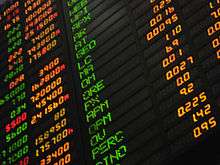Bankers' acceptance
| Financial markets |
|---|
 |
| Bond market |
| Stock market |
| Other markets |
| Over-the-counter (off-exchange) |
| Trading |
| Related areas |
A banker's acceptance, or BA, is a promised future payment, or time draft, which is accepted and guaranteed by a bank and drawn on a deposit at the bank. The banker's acceptance specifies the amount of money, the date, and the person to which the payment is due. After acceptance, the draft becomes an unconditional liability of the bank. But the holder of the draft can sell (exchange) it for cash at a discount to a buyer who is willing to wait until the maturity date for the funds in the deposit.
A banker's acceptance starts as a time draft drawn on a bank deposit by a bank's customer to pay money at a future date, typically within six months, analogous to a post-dated check. Next, the bank accepts (guarantees) payment to the holder of the draft, analogous to a post-dated check drawn on a deposit with over-draft protection.
The party that holds the banker's acceptance may keep the acceptance until it matures, and thereby allow the bank to make the promised payment, or it may sell the acceptance at a discount today to any party willing to wait for the face value payment of the deposit on the maturity date. The rates at which they trade, calculated from the discount prices relative to their face values, are called banker's acceptance rates[1] or simply discount rates. The banker's acceptance rate with a financial institution's commission added in is called the all-in rate.
Banker's acceptances make a transaction between two parties who do not know each other safer, because they allow the parties to substitute the bank's credit worthiness for that who owes the payment. They are used widely in international trade for payments that are due for a future shipment of goods and services. For example, an importer may draft a banker's acceptance when it does not have a close relationship with and cannot obtain credit from an exporter. Once the importer and bank have completed an acceptance agreement, whereby the bank accepts liabilities of the importer and the importer deposits funds at the bank (enough for the future payment plus fees), the importer can issue a time draft to the exporter for a future payment with the bank's guarantee.
Banker's acceptances are typically sold in multiples of US $100,000.[2] Banker's acceptances smaller than this amount are referred to as odd lots.
History
Bankers' acceptances date back to the 12th century when they emerged as a means to finance uncertain trade, as banks bought bills of exchange at a discount. During the 18th and 19th centuries, there was an active market for sterling bankers' acceptances in London. When the United States Federal Reserve was formed in 1913, one of its purposes was to promote a domestic bankers' acceptance market to rival London's to boost US trade and enhance the competitive position of US banks. National banks were authorized to accept time drafts, and the Federal Reserve was authorized to purchase certain eligible bankers' acceptances, but today the US central bank no longer buys banker's acceptances (but instead buys mostly US government bonds from a Primary dealer).
In The PRC, Banker’s Acceptance Notes(BANs) have become a shadow currency with captive banks of local governments issuing BANs to hide their debt levels.[3]
Comparison with other drafts
When a draft promises immediate payment to the holder of the draft, it is called a sight draft. Cheques written on demand deposits are examples of sight drafts. When a draft promises a deferred payment to the holder of the draft, it is called a time draft. The date on which the payment is due is called the maturity date. In a case where the drawer and drawee of a time draft are distinct parties, the payee may submit the draft to the drawee for confirmation that the draft is a legitimate order and that the drawee will make payment on the specified date. Such confirmation is called an acceptance — the drawee accepts the order to pay as legitimate. The drawee stamps ACCEPTED on the draft and is thereafter obligated to make the specified payment when it is due. If the drawee is a bank, the acceptance is called a banker's acceptance. Bankers acceptances are considered eligible collateral under the Treasury Tax & Loan (TT&L) Program under 31 CFR part 203
Notes
- ↑ Bodie, Zvi. "Investments", page 28, 6th Canadian Edition. Canada: McGraw-Hill Ryerson, 2008
- ↑ Veale, Stuart R. (2001). "Stocks, Bonds, Options, Futures", New York Institute Of Finance
- ↑ Lowenstein, Matthew (12 December 2013). "Bankers acceptance notes are financing tremendous speculation in China’s provinces. How long can this last?". thediplomat.com. The Diplomat. Retrieved 26 December 2013.